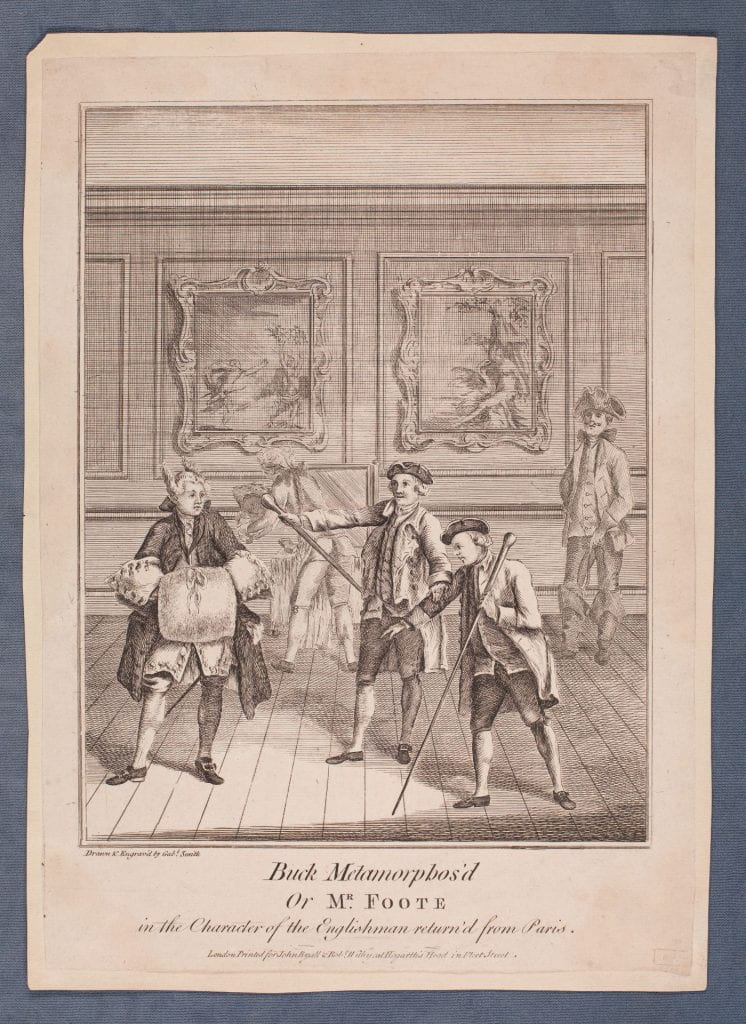
“A scene in the Empress’s dressing-room. Marie Louise is horror-struck at the appearance of Napoleon who advances towards her in profile astride the back of a crawling Mameluke; he is held up by two other Mamelukes who support his arms and shoulders. He is terribly emaciated and appears moribund. He wears uniform; his legs, feet, and hands are swathed in bandages, his (former) ear and nose covered with black patches. The crawling Mameluke, presumably Roustan, holds out a bottle containing a pointed nose, and labelled ‘Le Nez de l’Empereur’. Immediately behind Napoleon and his three supporters are two kneeling Mamelukes, each reverently holding a tasselled cushion supporting a bottle; one being labelled ‘Les Doights [sic] de l’Empereur Napole . . .’, the other, ‘Les Oreilles de l’Empereur Napoleon’. Behind them (left) another Mameluke advances with a bottle labelled ‘Les Doights du pied de l Empereur Bon . . .’ The Mamelukes wear Turkish dress with turbans. Napoleon looks in tragic silence at his wife, who is seated in regal state but turns aside weeping with violent gestures of despair. A small terrestrial globe decorates her chair; her foot rests on a stool in the form of a flattened polar hemisphere on which the word ‘Brit[ain]’ is visible. Over her low-cut dress is an ermine-bordered robe clasped with a fleur-de-lis. She is supported by an emaciated court-lady, with a patched face, proffering a smelling-bottle, whose profile and a small crown show that she is one of Napoleon’s sisters; two other ladies, wearing crowns, stand behind the Empress, registering consternation. A less conspicuous lady weeps. On the Empress’s right kneels the Governess of the King of Rome, Mme de Montesquiou, holding the screaming child, and weeping noisily. He registers angry terror at the sight of his father; his little crown has fallen off. His features, though fore-shortened and distorted, resemble those of his father, cf. British Museum Satires No. 11719. He wears an ermine-trimmed robe over his childish tunic and breeches. Behind the Governess is a draped dressing-table, the drapery decorated by a large fleur-de-lis, and the toilet boxes ornamented with crowns. A terrified monkey climbs up the mirror, clutching at the crown which surmounts it, and looking over its shoulder at the shocking spectacle presented by the Emperor. On the extreme right a lap-dog stands on a cushion barking furiously at Napoleon. On the ground on the extreme left are two large round coffers, one inscribed ‘Coffre Pour la Bijoutère [sic] Russe’, the other expectantly open. Voluminous draperies on the left and right, supported on the right by a pillar add to the regal character of the room.”–British Museum online catalogue.
- Printmaker: Cruikshank, George, 1792-1878, printmaker.
- Title: The hero’s return [graphic] / David pinxit ; etched by G. Cruikshank.
- Publication: [London] : Pubd. by H. Humphrey, St. James’s St., Feby. 22d, 1813.
Catalog Record
813.02.22.01+
Acquired June 2018



